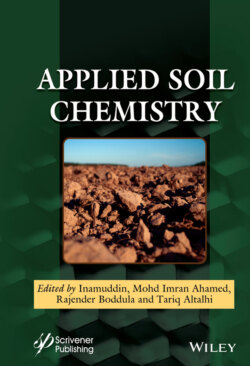Читать книгу Applied Soil Chemistry - Группа авторов - Страница 15
1.1 Introduction
ОглавлениеToday, more than ever, the impact of the advancements in a wide range of technologies and artificial intelligence are influencing progresses and development of human life across the world. In this regard, we can point out ultrasonic application [1], carbon dioxide issue [2], medical research [3–8], and new chemical methods [9] are all advancing rapidly with their impacts being felt more widely. “Sequestration” of combines both the capture of carbon dioxide (CO2) and its long-term isolation from the atmosphere and ocean, storing it safely and securely for thousands of years.
Carbon sequestration in soils, to absorb some of the unwanted CO2 in the atmosphere, mainly involves adopting improvements in land management. This means adopting practices, on a large scale, that convert more atmospheric CO2 into carbon stored in soils than current practices achieve. The main potential to improve carbon management techniques applies to cropland and grazing lands [10]. These improved land use and carbon management techniques strive to increase the rate of biomass entering the soils and/or by reducing the rates of turnover of organic carbon already residing in the soils and by increasing the quantity of soil carbon that becomes mineralized. Through carbon sequestration in soils, CO2 is to a degree stabilized in soils on a semi-permanent basis. However, to achieve this, the CO2 needs to be converted into other materials. These chemical changes are initiated primarily through organic processes. CO2 is involved in a complex cycle which includes a circulation through the soil influenced by a range of micro-biological activity. Through this circulation, CO2 becomes available in soils to be dissolved by percolating rainwater. This leads to the formation of carbonic acid in near surface fluids.
On a global scale, soils store about 1,500 Pg (petagrams, equivalent to 1,500 gigatonnes) of organic carbon to a depth of one meter, increasing to 2,400 Pg to a depth of 2 m [11]. This means that carbon residing in upper soil layers amounts to more than the combined quantity of carbon in land-surface vegetation and the atmosphere. A little less than 50% of soils globally have been or are in use for agriculture, both cropland and grazing land. The soils involved in cropland activity have almost all been disturbed by some form of tillage. Organic matter within soils can vary between about 1% and 10%.
Subsequently, that carbonic acid reacts with basic cations leading to the creation of secondary carbonates in the short-term, on the scale of years, forming mineralization in near-surface rocks, leading to sustained processes that persists over geological timescales. The creation of secondary carbonates comes mainly from sub-surface weathering and diagenesis reactions with silicate minerals containing calcium and magnesium. Such reactions generate free positively charged ions (cations). Many of these free cations go on to combine with CO2 to form carbonate minerals, particularly calcite and dolomite [12]. However, these pervasive carbonate forming diagenetic processes tend to progress too slowly in their natural cycles to be practically exploited for carbon sequestration purposes. Nevertheless, they do involve substantial quantities of CO2, particularly in alkaline and saline soils present in dry and semi-dry zones [13]. Consequently, the inorganic sub-surface carbon cycle cannot be considered as significant or viable for rapid carbon sequestration in the soils typically found in the soils of wet and temperate zones.
On the other hand, organic carbon can cycle through soils, some returning to the atmosphere very rapidly. In the organic dimensions of the carbon cycle, atmospheric carbon dioxide is stabilized through the photosynthesis conducted by plants, algae, and cyanobacteria to form a range of organic compounds. Although the living organisms initially form glucose during photosynthesis, they transform it into diverse organic compounds, such as cellulose, hemicellulose, and lignin mostly; materials that are useful for biological growth and tissue formation. However, other complex organic materials such as protein, lipids, including more intricate compounds used to provide various benefit to plants and bacteria, are also formed. Land plants direct a significant portion of photosynthetic products to their roots, some of which are released to the soil as soluble carbon compounds; products termed as rhizoexudates [14].
Figure 1.1 Schematic diagram illustrating the biological contributions to the carbon cycle via terrestrial soils.
When plants and bacteria die, their organic constituents are dispersed in soils through decomposition by soil micro-organisms. That decomposition releases much of the CO2 they captured during photosynthesis making its way out of the soil to return to the atmosphere (Figure 1.1). This organic matter-soil decomposition cycle contributes CO2 output to overall soil respiration that includes respiration of plant root and flora and fauna that live in the soil. In addition to the contributions of plants, algae, and cyanobacteria to the carbon cycle through soils, there is a substantial sub-cycle that is related to contributions from animals. The animals consume CO2 in the form of food, with animal excrements and corpses returning to the soil and being decomposed along with plant, algae, and cyanobacteria remnants.
